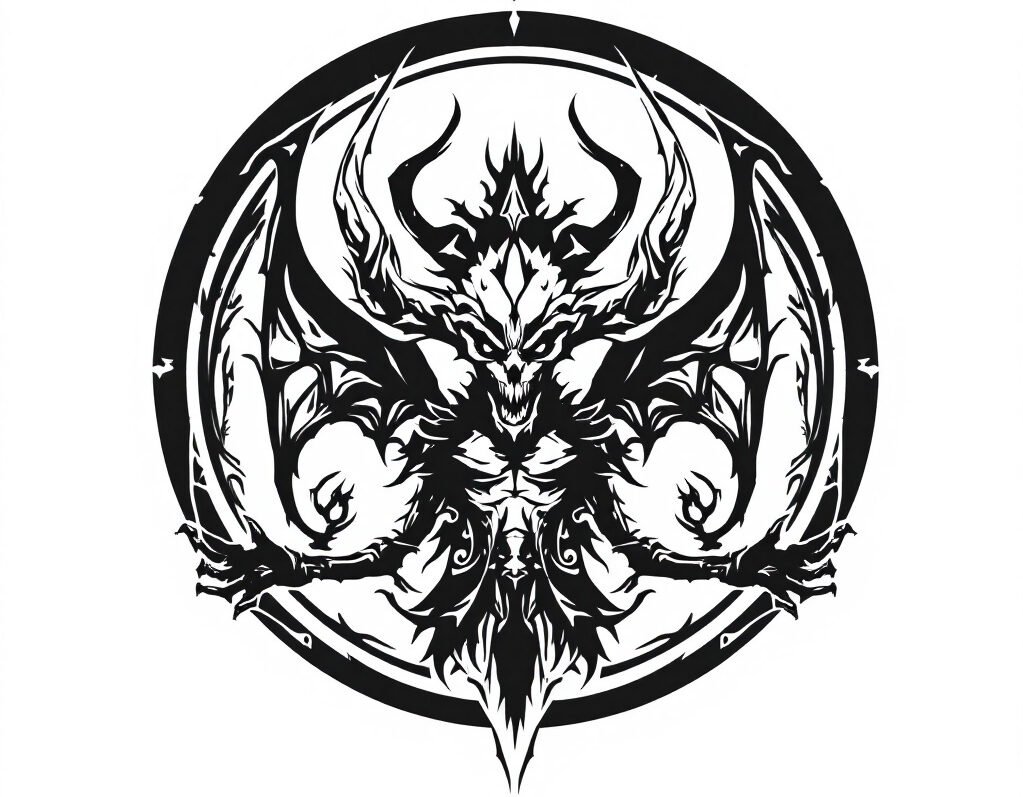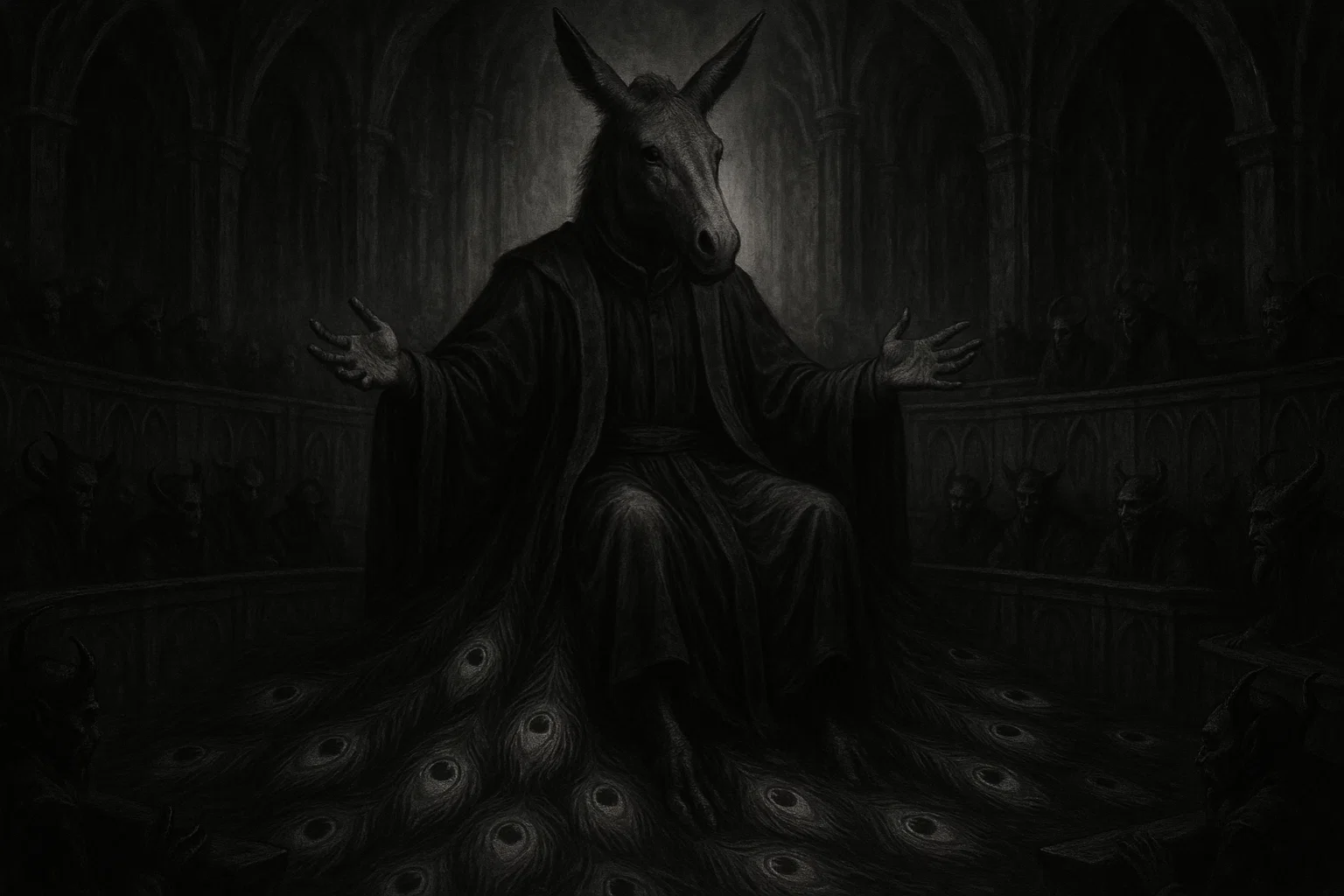Adrammelech is a strange and mysterious demonic entity in the world of demonic lore, blending ancient pagan roots with later Christian views of evil.
Once revered as a sun god in ancient Semitic cultures, he became a fallen angel and a high-ranking demon in Judeo-Christian texts. His name pops up in the Bible as a deity tied to cruel child sacrifices, marking him as a symbol of forbidden worship.
Over time, occult writers painted him as a cunning leader in hell’s ranks, overseeing dark councils and even Satan’s clothes. This shift illustrates how early gods often evolved into demons as new faiths gained prominence.
Summary
Key Takeaways
| Attribute | Details |
|---|---|
| Names | Adrammelech, Adramelech, Adramelek, Adar-malik, Adramaleck |
| Title | Grand Chancellor of Hell, President of the Senate of Demons, Supervisor of Satan’s Wardrobe, Chief of the Order of the Fly |
| Gender | Male |
| Role | Tempter through guile and ambition, overseer of infernal politics, promoter of rebellion against divine order |
| Hierarchy | High-ranking archdemon, 8th of the 10 evil Sephiroth, under Samael in the Qliphoth |
| Servitors | None specifically named; commands lesser spirits in hell’s council |
| Superior Demon | Samael (primary overseer), Satan/Lucifer (ultimate authority) |
| Powers | Induces excessive pride and deceit, grants knowledge of hidden orders, manipulates infernal hierarchies to sow discord |
| Appearance | Human upper body with mule head, peacock tail, and mule or peacock limbs; sometimes a full peacock or ass form |
| Etymology | From Hebrew “Adir-melech” meaning “magnificent king” or “glorious one is king”; possible links to “Adar is prince” or sun god titles |
| Associated Figures | Anammelech (companion deity), Asmodeus (fellow fallen throne angel), Moloch (similar sacrifice ties) |
| Weaknesses | Vanquished by archangels like Uriel and Raphael; repelled by divine light and holy invocations |
| Opposing Angel/Saint | Uriel, Raphael (archangels who defeated him in heavenly war) |
| Pantheon | Judeo-Christian demonology with Assyrian/Babylonian influences |
| Legions | None; focuses on council leadership rather than direct command of legions |
| Element | Fire (primary, tied to sun and destruction) |
| Planet/Zodiac | Sun; Capricorn (in some modern occult ties) |
| Color(s) | Black, white, purple, blue (symbolizing hidden power and vanity) |
| Number(s) | 8 (as 8th evil Sephira), 32, 47, 95 (magickal links) |
| Crystal(s)/Mineral(s) | None directly; fire-associated like ruby or obsidian in modern extensions |
| Primary Sources | Bible (2 Kings 17:31, 19:37; Isaiah 37:38), Dictionnaire Infernal (Collin de Plancy), Paradise Lost (John Milton), Pseudomonarchia Daemonum (Johann Weyer), A Dictionary of Angels (Gustav Davidson), Der Messias (Friedrich Klopstock), Philosophie Occulte (Eliphas Levi) |
“Adrammelech” Meaning
The meaning of the name “Adrammelech” can be found in the ancient Semitic languages, where names held real power and hinted at a being’s nature. At its core, Adrammelech breaks down to “Adir-melech” in Hebrew, blending “adir” for “magnificent” or “glorious” with “melech” for “king.”
This paints him as the “magnificent king.” A title that screams pride and rule over flames or the Sun’s harsh light. Early scholars viewed this as a nod to his former role as a sun god, where glory meant burning strength that could both warm and destroy.
In Assyrian lands, names like this were often associated with gods who instilled fear through fire rituals, making the Adrammelech inherently one of fiery command from the start.
The name also carries layers of royal claim, with “melech” appearing in other ancient titles for rulers or gods, emphasizing his high status before he fell into the ranks of demons.
Over the centuries, the name evolved in response to conquests and shifts in faith. In Babylonian texts, hints point to “Adar-malik,” where “Adar” refers to a month associated with the thunder god Adad, and “malik” means “prince” or “counselor.”
This strange twist may suggest “Adar is prince,” shifting focus from raw kingship to sly advice in shadows—perfect for a demon who plots in hell’s halls. Talmud writers added layers, saying the name mixes “to carry” (as in bearing burdens of sin) with “king,” implying he hauls souls into rebellion.
Symbolic takes go even darker: that “glorious” part mocks true divine light, turning it into false shine that blinds followers to evil paths. In occult circles, this evolution marks Adrammelech as a bridge from pagan honor to Christian sin, where his name whispers of fallen stars craving thrones they lost.
Some old views link it to “Adadmelech” or “Hadad is king,” due to letter mix-ups in scripts, tying him to storm gods whose power rained down like fire. Others derive “Atra-malik” from Akkadian, meaning “exceeding king,” which points to the overreach that sparked his downfall.
The etymology of the name also ties in with peacock feathers, from Persian lore, where birds were associated with vanity. Some claim the name echoes “atra-malik,” akin to Akkadian “exceeding king,” hinting at overreach that led to his heavenly boot. In grimoires, variations like Adramelek stress the “lek” sound, evoking trickster tongues that twist words into lies.
How to Pronounce Adrammelech in English
The name Adrammelech comes out as uh-DRAM-uh-lek in English speech. Break it down: “Ad” like “add,” “ram” as in the animal, “me” soft like “meh,” and “lech” rhyming with “leck.” Stress falls on the second beat, making it flow smoothly without hard stops.
What Does Adrammelech Look Like?
Adrammelech takes forms that blend human craftsmanship with bestial pride, drawn directly from ancient occult sketches and texts.
In most sources, the demon appears with a man’s chest and arms, but a mule’s long face—stubborn and sly, like a beast that hauls loads without complaint. He’s also depicted with mule legs that stomp the ground, while a peacock’s tail fans wide behind.
The best representation of this demon is in Collin de Plancy’s Dictionnaire Infernal, where the artist Louis Le Breton caught this in ink—head high, tail spread, a chancellor who dresses hell’s king but craves the spotlight himself.
Origins
Adrammelech’s origins trace back to the dusty corners of the ancient Near East, where gods rose from city fires and fell under the rule of foreign powers.
His earliest marks appeared in Assyrian and Babylonian lands around 700 BCE, as a sun deity for the Sepharvaim folk—likely twin spots like Sippar on the Euphrates, hubs of star worship and royal power. There, he ruled fertility’s harsh side: crops from sun warmth, but kids burned on altars to beg his favor.
This mix of life-giver and taker set him apart from softer gods, pulling in thunder ties from Adad, the storm lord whose rains fed fields or floods wiped them. As a Semitic god, his worship spread through trade routes, blending with local rites in places like Hamath and Arpad, where sun kings demanded blood for power.
As empires clashed, Adrammelech crossed into the Hebrew world via Assyrian grabs of Israel. Exiled Sepharvites dragged their idols to Samaria, clashing with Yahweh’s one-god rule. Bible writers branded him a false prophet, a sign of sin’s pull on strayed tribes.
By Talmud times, rabbis spun him as an ass-shaped mock-god, a lowly beast for a haughty name. This demon slide hit full in the Christian era: pagans became devils, sun kings turned fallen stars.
You may also enjoy:
Agubanba: The Ash-Born Demon of Japanese Folklore
October 23, 2025
Who Is Abalam in Demonology? The Terrifying King That Serves Paimon
September 30, 2025
Ifrit: Demon of Fire Who Serves Iblis in Islamic Tradition
September 30, 2025
Abadir: The Demon Servant of Chaos and Dispersion
September 30, 2025
Who Was Abezethibou, the Fallen Angel Who Opposed Moses?
October 1, 2025
What Is Qarin and Why Does It Follow Every Human Being?
October 8, 2025
Was Adrammelech Ever Mentioned in the Bible?
Yes, Adrammelech appears twice in the Old Testament, both in 2 Kings, as a foreign god mocked for weakness.
First, in 2 Kings 17:31, he ties the Sepharvites’ sins—burning kids in fire rites after Assyrian exile to mixing faiths. This verse slams mixed worship as a curse’s root, Adrammelech as false light pulling Israel from God.
Second, 2 Kings 19:37 (echoed in Isaiah 37:38) names him as the son of Sennacherib, Assyrian king slain in Nisroch’s temple by Adrammelech and brother Sharezer.
Here, he’s no god but a murderer, fleeing to Armenia—irony of an idol-worshipper killed mid-prayer.
| Source | Quote |
|---|---|
| 2 Kings 17:31 | The Sepharvites burned their children in the fire as sacrifices to Adrammelech and Anammelech, the gods of Sepharvaim. |
| 2 Kings 19:37 | It came to pass, as he was worshiping in the house of Nisroch his god, that Adrammelech and Sharezer his sons smote him with the sword: and they escaped into the land of Armenia. And Esar-haddon his son reigned in his stead. |
| Isaiah 37:38 | And it came to pass, as he was worshipping in the house of Nisroch his god, that Adrammelech and Sharezer his sons smote him with the sword; and they escaped into the land of Armenia: and Esarhaddon his son reigned in his stead. |
| 2 Kings 18:34 | Where are the gods of Hamath and Arpad? Where are the gods of Sepharvaim, Hena and Ivvah? Have they rescued Samaria from my hand? |
| Isaiah 36:19 | Where are the gods of Hamath and Arpad? Where are the gods of Sepharvaim? Have they rescued Samaria from my hand? |
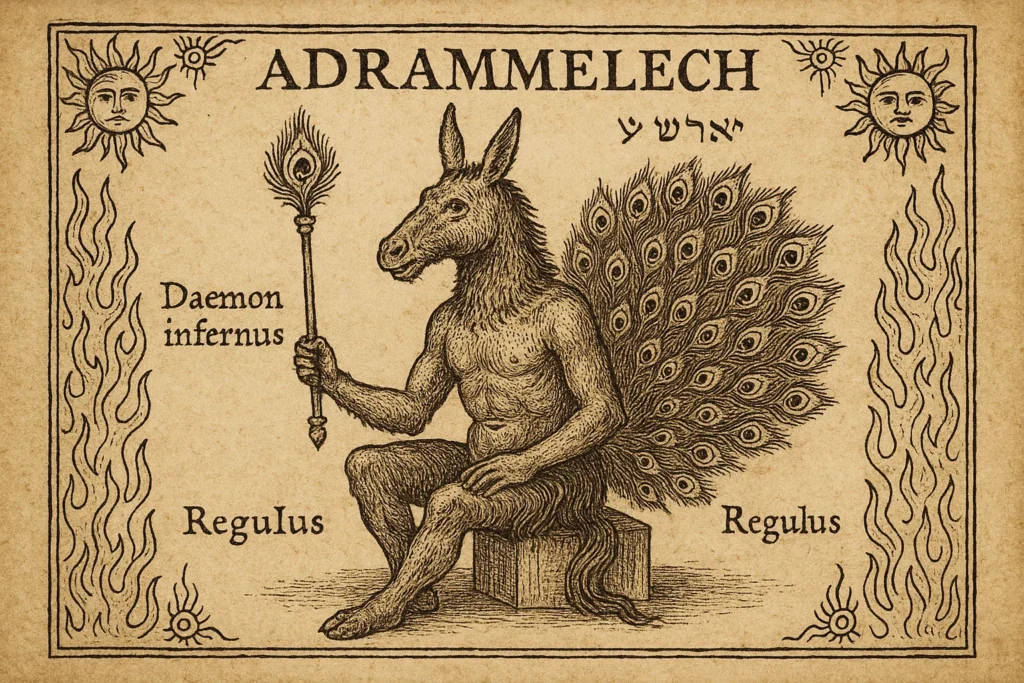
Adrammelech in Grimoires and Other Texts
Beyond the Bible pages, Adrammelech struts in occult shelves as hell’s sharp-dressed plotter:
| Source | Quote |
|---|---|
| Dictionnaire Infernal (Collin de Plancy) | Adramelech is the president of the devils’ general council; he is also the chancellor of hell and supervisor of the devil’s wardrobe. |
| Paradise Lost (John Milton, Book 6) | Uriel and Raphael his vaunting foe, Though huge, and in a rock of diamond armed, Vanquished Adramelech, and Asmadai, Two potent Thrones, that to be less than Gods Disdained… |
| Der Messias (Friedrich Klopstock, Book II) | First appeared Adramelech, a spirit in guile and malice exceeding Satan, against whom his bosom still boiled with indignant rage… From years immemorial he had been considering how to raise himself to the dominion of hell… |
| Philosophie Occulte (Eliphas Levi, Serie II) | The eighth Sephira is Hod or eternal order… They have for adversaries the Samael or jugglers, whose Chief is Adramelech. |
| Pseudomonarchia Daemonum (Johann Weyer) | Adramelech is a great marquesse, and is seene as a horsse… He is under the power of Amaymon… |
Powers and Abilities
Adrammelech wields dark gifts rooted in cunning rule, all bent on dragging souls into pride’s pit. His strengths focus on mind twists and power grabs, with no light or aid—just snares for the ambitious.
- Induces Guile and Deceit: He plants lies that fester, making hosts scheme against kin or gods.
- Grants Forbidden Knowledge of Order: Reveals hell’s ranks and hidden laws, teaching how to climb thrones through betrayal.
- Manipulates Infernal Politics: As senate head, he sways demon votes for chaos wars, pitting lords like Satan against each other.
- Solar Fire Command: Calls sun-like blasts to scorch foes or blind with false glory.
- Vanity Amplification: Swells egos to bursting, turning leaders to tyrants who fall alone.
- Council Binding: Forces lesser spirits to oaths of discord, building rebel packs.
Adrammelech Myths, Legends, and Stories
The Fall of Adrammelech in Paradise Lost
In the grand battle of the heavens, where angels fought against each other, Adrammelech was a powerful combatant, armored in shining plates that sparkled like stars. He stood tall alongside Asmadai, both looking down on those of lesser ranks, dreaming of thrones that even God could not grant them.
The first to confront them was Uriel, a fierce warrior of light, whose bright spear cut through the shadows, striking Adrammelech with a holy wrath. Raphael joined the fight next, his sword slicing through the air and landing heavy blows on Adrammelech’s armor.
The clash echoed across the celestial fields, with thrones battling against seraphs amidst a cacophony of brilliant light and thunderous roars.
Wounds opened wide, spilling the blood of the fallen angels onto the holy ground, hissing as it hit the surface. Adrammelech let out a furious roar, his face twisted in anger. At the same time, his extravagant tail lashed out like a deceptive whip.
He launched tricks and illusions, creating false victories to mislead weaker opponents. Still, the loyal defenders saw through his deceitful tactics. Asmadai fell beside him, armor torn and spirits broken, as their aspirations for godhood crumbled.
Defeated and wounded, they retreated, shedding their pride like broken promises. The heavens trembled as they fled, teaching a harsh lesson: even the mightiest thrones can fall when envy ignites conflict.
From their hiding places below, Adrammelech plotted his revenge, his downfall setting in motion a dark rebellion.
Meanwhile, the loyal angels pursued them, their banners bright against the fading stars, making sure no rebellious throne escaped punishment. In the aftermath of the battle, the heavens were filled with songs of victory, while the fallen bandaged their wounds in exile, with Adrammelech’s shattered armor pieces left as reminders of their overreach.
Adrammelech’s Scheme in Der Messias
Long before the stars began to spin, there was a spirit named Adrammelech who simmered in the halls of heaven. His bitterness and anger were even stronger than Satan’s. The demon roamed the heavenly realms, his eyes fixated on the throne of the Eternal, plotting schemes that would take ages to unfold.
He was the first to imagine a great rebellion. He began whispering doubts into the ears of the seraphs, planting seeds of betrayal in their hearts.
But his anger grew when Satan took the lead in this uprising because Adrammelech believed he should be the true architect of their plans, not just a supporting player. His mind was like a volcano, filled with hidden ideas for how he could seize control without relying on Satan.
In the depths of hell, he gathered shadows around him, changing his form—sometimes appearing as a peacock to show off and other times as a mule to bide his time. “Why should we follow this newcomer?” he sneered to the other dark spirits, his voice smooth but powerful. “I’m the one who plotted this rebellion and deserve to wear the crown.”
He laid out his plans like a dark blueprint: tempt Satan into a fresh attack on the throne above, luring him with promises of glory until he could be trapped. If that failed, he could rally the dark forces for a chaotic battle to snatch the power away from the defeated. The other spirits eagerly agreed, excited to follow Adrammelech’s clever leadership.
Satan, sensing the murmurs of discontent, looked through the darkness and said, “Fallen brother, your fire helps my cause, but your jealousy eats you alive.” Adrammelech bent humbly, his tail feathers shaking, but his eyes were full of daggers. He continued to weave his schemes, turning the loyalty of others into doubt.
As battles erupted and the heavens rumbled, Adrammelech slipped through the chaos to whisper in Satan’s ear: “Strike here, and the victory is yours—just let me claim my quiet part below.” Satan hesitated, sensing a trap, and in that moment, the loyalty of his followers returned. Adrammelech’s plans fell apart, and his allies scattered like ashes in a storm.
Banished deeper into hell, he brooded over his failure, forever plotting to claim the throne that had been denied to him. His resentment festered like a poison among the damned, with the memory of his failed uprising keeping the intrigue alive in the darkness.
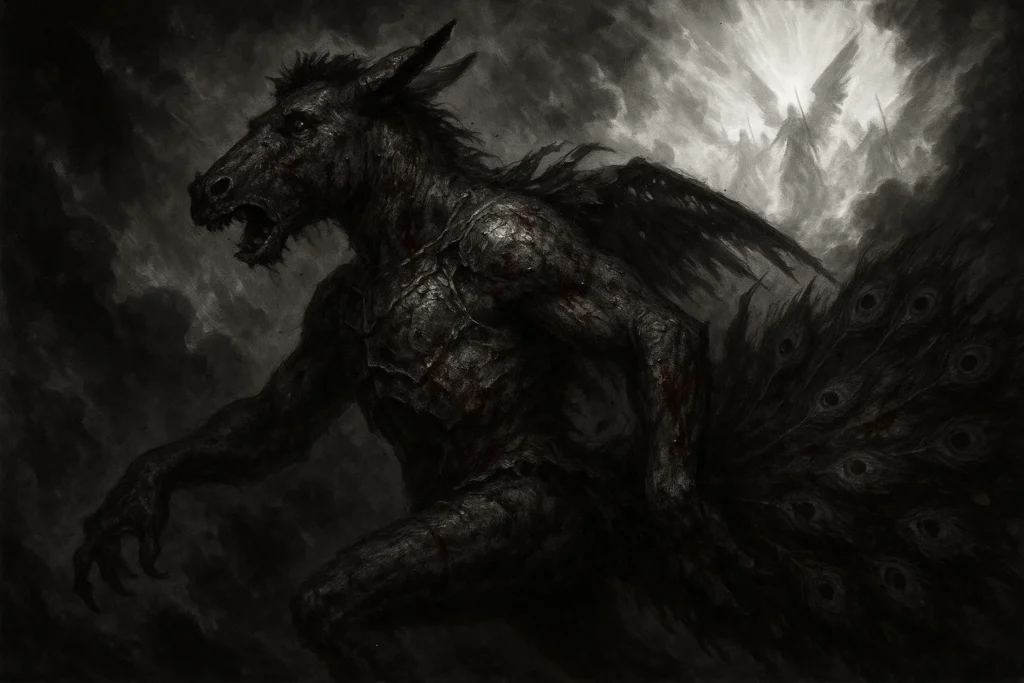
The Worship and Curse of Sepharvaim
In the ancient city of Sippar, where the Euphrates River shaped the land, people dedicated magnificent towers to Adrammelech. This sun god could either bless them with golden fields or scorch them to ash.
Alongside the moon goddess Anammelech, he demanded sacrifices—young goats were offered on burning altars at dawn, their tiny bodies consumed to satisfy his hunger for eternal power.
Priests sang praises to him, accompanied by drums that echoed like heartbeats, sending smoke spiraling upward in prayer. The city thrived with bountiful rain and conquered enemies, but this came at a terrible cost—people screamed as blood was spilled to appease the gods.
Grand temples displayed shining golden idols that caught the sun’s light, where families brought gifts in the hope of good harvests and victories in battle.
But as the Assyrians swept through, bringing chains and turmoil, the shadow of Yahweh loomed over them. Despite this, old traditions continued in secret—people whispered Adrammelech’s name quietly, hiding their rituals.
Israelite leaders noticed and warned that these “false gods” were draining their strength. Kings dispatched spies, but the ceremonies remained hidden, and children continued to vanish into the night.
One evening, a prophet unveiled a truth: Sennacherib’s own son, Adrammelech the prince, had fled to them after a bloody event in the temple, desperate for divine favor. In the echoes of Nisroch, he reignited sacrificial flames to reclaim lost power. These secret rituals, mingling with local beliefs, angered the divine forces with their persistence.
Heaven reacted in fury—plagues spread, water sources dried up, and shadows grew ominous. The exiled people trembled as their altars collapsed in earthquakes. Adrammelech’s terrifying image flickered in smoke, depicted with a mule’s head and peacock eyes shedding oil, before his influence faded away.
Samaria became a scarred reminder that even the mightiest sun kings could fall when one true God calls for justice. The prince disappeared into the wilderness of Armenia, leaving behind a God once revered, now seen as a curse, and the cold remnants of his pride.
You may also enjoy:
Who Was Ravana in Hindu Mythology and Why Was He Feared?
October 3, 2025
Who Is Adrammelech in Demonology and the Bible?
October 1, 2025
Palden Lhamo: The Black Goddess of Blood and Protection
October 20, 2025
Who Is Jann in Islamic Mythology and Why Is He Feared?
October 2, 2025
Aamon: The Infernal Marquis of Lust, Feuds, and False Prophecies
September 29, 2025
Banasura: The Thousand-Armed Demon King
October 10, 2025
Adrammelech vs Other Similar Demonic Entities
| Demon Name | Associated Sin/Temptation | Rank/Origin | Key Traits/Powers |
|---|---|---|---|
| Asmodeus | Lust and wrath | King of demons; Ars Goetia, Testament of Solomon | Three-headed form (bull, man, ram); destroys marriages, teaches math and arts through rage |
| Belial | Lawlessness and lies | Prince of Hell; Dead Sea Scrolls, Ars Goetia | Commands 80 legions; appears as beautiful angel or charioteer, sows discord in courts |
| Moloch | Child sacrifice and greed | Ammonite god demonized; Bible, Milton | Bull-headed giant; demands blood offerings, grants wealth via fire rites |
| Beelzebub | Gluttony and possession | Lord of Flies; Philistine god, Ars Goetia | Winged insectoid; rules eastern hell, exorcism foe, spreads plagues and false gods |
| Baal | Pride and idolatry | Canaanite storm god; Bible, grimoires | Horned thunder-bringer; 66 legions, reveals invisibles, incites false worship storms |
| Astaroth | Sloth and discovery | Duke of Hell; Ars Goetia, Grand Grimoire | Foul angel on dragon; teaches sciences but corrupts with lazy secrets, reveals past/future lies |
| Mammon | Greed and inequality | Treasurer of Hell; New Testament, medieval lore | Wolf-faced hoarder; tempts with riches that bind souls, divides through envy |
| Leviathan | Envy and chaos | Sea serpent; Bible (Job, Isaiah), Kabbalah | Coiled dragon of depths; guards hell’s west, floods minds with jealous waves |
| Abaddon | Destruction and locusts | Angel of the pit; Revelation, Talmud | Winged destroyer; unleashes plagues, bottomless pit lord, annihilates without mercy |
| Pazuzu | Winds and famine | Mesopotamian demon; exorcist texts, folklore | Winged lion-man; storms bring disease, protects from rivals but starves the weak |
| Lilith | Seduction and infanticide | Night demon; Jewish folklore, Zohar | Winged seductress; steals children, tempts men in dreams, first wife’s vengeful shadow |
| Nergal | War and plague | Underworld god; Babylonian, Bible | Lion-headed warrior; rules south hell, spreads fever-arrows, gates death’s realm |
| Dagon | False prophecy | Philistine fish-god; Bible, grimoires | Half-fish merman; drowns sailors in lies, topples temples with tidal deceit |
| Eurynomos | Corpse-eating and despair | Greek underworld; Pausanias, demonology | Blue-skinned flayer; strips flesh from dead, whispers hopelessness to living |
| Demogorgon | Terror and duality | Chaos lord; medieval grimoires, folklore | Two-headed demon; splits minds with fear, births abominations from rifts |
Adrammelech’s Rank in the Hierarchy of Hell
Adrammelech is a high-ranking demon in the dark hierarchy of hell, working behind the scenes like a clever strategist in a corporate boardroom filled with chaos.
He is often described as the Grand Chancellor, a crucial player in the devilish council where demons plot their plans against heaven, almost like a secretary counting votes while wearing a confident smile.
Some texts say he stands under the command of another demon named Amaymon. Still, others rank him even higher as the leader of the council of devils, managing things from the shadows like an infernal tailor crafting schemes.
In more mystical teachings, he ranks eighth among the ten evil influences, spreading confusion and lies while overseeing the chaos from the dark side.
He aligns with powerful figures like Beelzebub, gathering information and using his influence like a fly buzzing around to distract his enemies. His strength lies not in leading armies or wielding swords, but in his ability to influence and manipulate powerful individuals from a distance.
Despite not commanding legions (like other high-ranking demons), Adrammelech has a network of rivalries and alliances.
Some demons (like Lucifuge) dislike his style, while others (like Belial) tease him for his vanity. However, he is strategic, often leaking secrets that set his rivals against one another, showing his skill in playing the long game.
His alliances are constantly changing, sometimes teaming up with Moloch for fiery rituals or betraying others to shine on his own.
In this twisted hierarchy, he is the cunning advisor who always seems friendly while secretly plotting for greater power, measuring his success by how many other powerful beings he manages to outmaneuver.
His connections with other dark figures (like Nergal in plague-related schemes or Astaroth in manipulative plans) emphasize the collaborative threats he poses, while his rivalries with those who have beaten Uriel in battle fuel ongoing grudges.
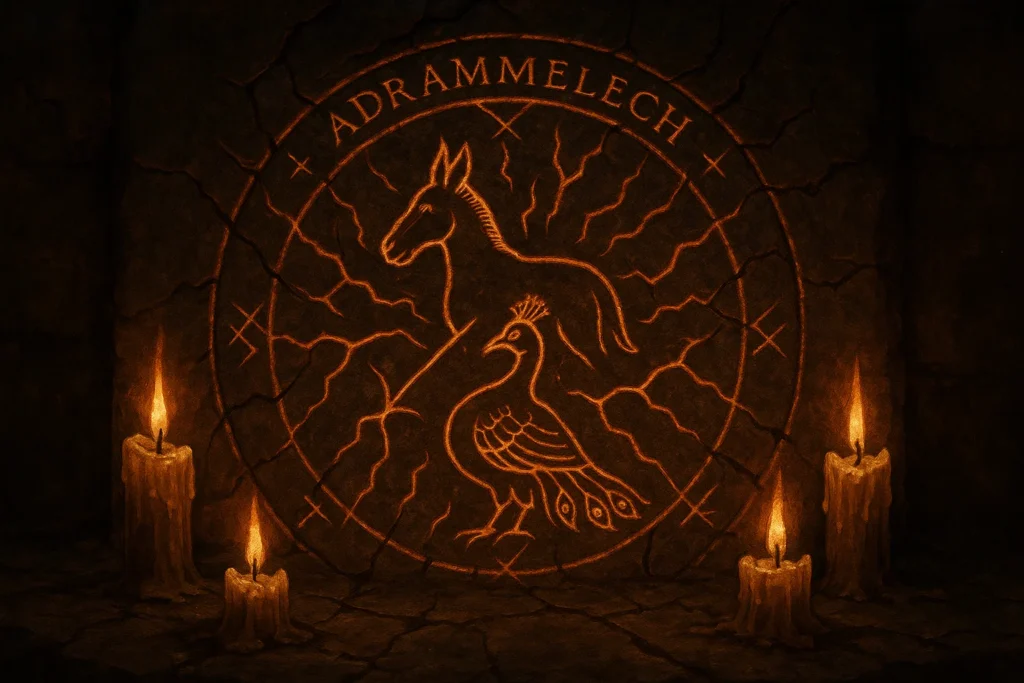
Associations
Adrammelech embodies a complex mix of traits that fuel his dangerous nature. He is driven by the fiery ambition of the Sun, seeking glory, while he uses Mercury‘s cleverness to twist the truth. At his core, he has a fierce fire that doesn’t offer warmth, but rather a fierce pride that consumes those who dare to pursue their ambitions too closely.
His influence reflects traits of Capricorn, symbolizing stubborn determination that can lead climbers to dangerous heights. The number 8 represents his endless deceit and trickery.
His appearance is marked by two striking colors: black (which hints at hidden dangers) and purple (representing a false sense of royalty).
Obsidian crystals symbolize his sharp, untrusting heart.
Zodiac and Astrological Links
Adrammelech incorporates the qualities of Capricorn (a zodiac sign known for its ambition and determination). Like a sturdy goat climbing a steep mountain, he tirelessly pursues his goals. This earth sign encourages patience, allowing him to carefully plot and wait for his rivals to make mistakes.
Capricorn’s strong traits resonate with Adrammelech’s humble appearance, reminding us that greatness can emerge from unexpected sources. He is like a chancellor, someone who carries heavy responsibilities while dreaming of power.
In ancient rituals, when stars like Sirius and Arcturus shone brightly, his fiery nature was enhanced, making him more powerful during ceremonies. Mars—the planet of war—sharpens his strategies, preparing him for confrontations.
Saturn, the ruling planet of Capricorn, brings a sense of discipline to his cunning plans. He builds elaborate traps that may take time to unfold. In astrology, his presence suggests a warning against being too ambitious during the cold winter months when compassion may be hard to find.
Mercury adds an element of cleverness, enabling him to skillfully manipulate conversations and ideas.
Elemental Associations
Fire drives Adrammelech’s power, originally a sun god whose blazing rituals ignited pride but now symbolizes ruthless destruction. This fire can shift from warmth to fierce flame, reminiscent of a peacock’s dazzling appearance that hides danger.
His abilities unleash scorching solar blasts that can harm bodies and souls, limited only by water or light. As a Sun deity, his fiery essence demands sacrifices and consumes without mercy, sparking chaos and conflict among wicked beings.
Air complements fire by carrying whispers and deceit, turning flames into obscuring smoke that confuses foes. Together, fire generates power while air spreads manipulation.
The earth provides stability to support his long-term schemes, reflecting his Assyrian origins with enduring clay forms.
In rituals, smoke from pyres symbolizes the intertwining of these elements, rising as distorted prayers toward the heavens.
Colors, Numbers, and Crystals
Black is Adrammelech’s primary color, consuming light like an eclipse and hiding secret dealings. In contrast, bright white symbolizes false purity, luring people in with clean lies before reality hits. These colors reflect his duality: black for his dark nature and white for his mocked glory from past Sun-god days.
Purple adds a touch of pride with regal robes that challenge the value of gold. At the same time, blue signifies his cold calculations, perfect for shady dealings.
Numbers are crucial to understanding him: 8 represents a cycle of pride, 32 symbolizes deceitful paths, 47 reflects bursts of aggression, and 95 connects to magical bonds that trap rivals.
Crystals enhance his persona: obsidian mirrors his sharp words; rubies represent his fiery spirit; and onyx grounds his stubborn plans. Together, these elements create a blend of power, drawing others into his schemes.
Other Correspondences
Metals like iron give strength to Adrammelech’s stubborn mule, while his chains secure the doors of hell with clever locks. Gold may tempt him, but it often tarnishes and betrays true friendships.
Surrounding him are poisonous plants (like nightshade and dark berries) that reflect his sinister plans, clouding judgment and quietly eliminating rivals with hemlock. The deceptive nightshade flowers once symbolized false glory in rituals.
Animals also play their roles; peacocks strut with beauty, watching sins unfold, while the mule represents stubborn defiance and reminds of Adrammelech’s fall from godhood.
Adrammelech’s Sigil and Symbols
Adrammelech is represented by a unique symbol found in ancient magical texts. This emblem resembles a mule’s head with a vibrant peacock tail. It has twisted horns and watchful eyes, with a complex, jagged design branching out into eight points, symbolizing decay.
However, his imagery also includes symbols of authority (like a mocking “king” represented by a mule) and the peacock that signifies indulgence. These icons narrate his story, tracing it from ancient traditions to demonic representations, often depicted surrounded by flames or lightning.
Crowns made of twisted gold represent his ambitious dreams, while a peacock scepter indicates his power among lesser spirits.
The symbols are powerful: some are inked on the skin for cunning gifts, while others are burned in rituals to summon dark forces. Together, they illustrate his transformation from divine to demonic.
Occasionally, his symbol includes elements from Kabbalistic traditions, hinting at twisted order and indicating his authority in infernal realms.
Summoning and Rituals
According to Weyer, using special mule-horn wands dipped in red ink, paired with soft chants of “Adir-melech” to create an electric atmosphere.
To shield the summoner from his gaze, they should wear purple veils to hide their face. De Plancy advises using mock garments resembling black silk thorns as a distraction.
Invoking holy names like Uriel can stop Adrammelech’s power. At the same time, dark mirrors and iron bells that chime eight times serve as simple yet effective tools for the ritual.
You may also enjoy:
Who Is Abalam in Demonology? The Terrifying King That Serves Paimon
September 30, 2025
Who Is Aka Manto, Japan’s Terrifying Red-Cloaked Yōkai?
October 24, 2025
Who Is Agares, the Demon of Earthquakes and Deception?
October 13, 2025
Abura-sumashi: The Potato-Headed Yōkai That Punishes Greed
October 23, 2025
Who Is Jann in Islamic Mythology and Why Is He Feared?
October 2, 2025
Who Is Agaliarept, the General of Hell Under Lucifer?
October 8, 2025
